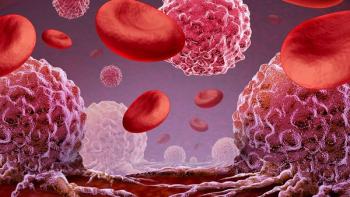
Identifying Rare Biomarker Could Help a Subset of Patients With Lung Cancer
RET rearrangements, while they only occur in about 1 percent of patients with non-small cell lung cancer, are nevertheless an important biomarker to identify, since targeted agents have proven to be beneficial in this patient population, and realizing a patient has the mutation can greatly impact their treatment plan, says Christine M. Lovly, M.D., Ph.D.
Christine M. Lovly, M.D., Ph.D.
Rearrangements in the RET gene, while they only occur in about 1 percent of patients with non-small cell lung cancer, are nevertheless an important biomarker to identify, since targeted agents have proven to be beneficial in this patient population, and realizing a patient has the mutation can greatly impact their treatment plan, says Christine M. Lovly, M.D., Ph.D.
In an open-label, single-center, phase 2 trial, the multikinase inhibitor Cabometyx (cabozantinib) had an overall response rate of 28 percent in patients with RET-positive lung cancer. However, there were notable toxicities observed.
“Lenvatinib (Lenvima) and vandetinib (Caprelsa) have also been studied in RET-positive lung cancer,” added Lovly in an interview with CURE.
Can you provide an overview of your recent presentation on RET fusions?
In the interview, Lovly, an assistant professor of medicine (hematology/oncology) and cancer biology, and a medical oncologist, Vanderbilt-Ingram Cancer Center, discussed the importance of identifying and targeting RET in NSCLC.One of my presentations was about RET-rearranged lung cancer. RET is a tyrosine kinase [a type of enzyme], similar to ALK, EGFR and ROS1. RET rearrangements occur in about 1 percent of lung cancer, predominantly in lung adenocarcinoma, and tends to be in patients who are never-smokers. There are retrospective studies, but some data suggest that it is more common in women than in men.
Can you discuss the current data with Cabometyx?
The importance of identifying RET rearrangements in lung cancer is because we have multiple agents that can potentially target RET. There are multiple trials that show the efficacy of these agents in patients with RET-positive lung cancer. Dr Alex Drilon and his colleagues at Memorial Sloan Kettering Cancer Center did a phase 2 trial of Cabometyx in patients with RET-rearranged or RET-positive lung cancer. The study, which included about 25 patients, used Cabometyx in patients who had been preselected to have RET rearrangements within their tumors. The response rate was upwards of 20 percent, but that was not what we would expect for oncogene-driven tumors treated with oncogene-directed tyrosine kinase inhibitors (TKIs).
What RET-specific inhibitors are being investigated?
In this case, Cabometyx came at the expense of a lot of toxicity. I should state that Cabometyx is not a RET-specific TKI, it is a multitargeted TKI, meaning it is not specific for RET but instead targets multiple different kinases. In this study with Cabometyx, about 75 percent of the patients needed a dose reduction because of toxicity. Those toxicities included several things, but, most notably, [was] an increase in liver function tests.In addition to Cabometyx, there are several different RET inhibitors that have been studied in RET-positive lung cancer. These agents are not specific for RET; they are multitargeted TKIs. For example, Lenvima and Caprelsa have also been studied in RET-positive lung cancer.
These are all predominantly phase 2 trials across the board with small cohorts of patients. Response rates were what we expect for TKIs in oncogene-directed lung cancers for these agents. The RET inhibitors Cabometyx, Lenvima and Caprelsa experience response rates of about 25 percent to 40 percent, but that is not the upward of 70 percent that we have seen in some of the ALK-positive or EGFR-mutant lung cancer trials.
One possibility is that the inhibitors are not specific against RET. We will need additional studies to look at this cohort. It’s a small cohort of 1 percent but so is ROS1, and yet, we have an FDA-approved drug for this space as well as some clinical studies showing the benefit of ROS1 inhibitors in patients with ROS1-positive lung cancer. I feel confident that, with the right drug, we can translate similar findings to other molecular cohorts, such as RET-positive lung cancer and target those patients effectively with specific targeted therapies that inhibit RET.
There has also been a very interesting study recently published in the Journal of Clinical Oncology at the end of 2016. It was with the global registry of patients with RET-positive lung cancer, and this study is a very exciting and important one. Though it was not a therapeutic trial, the study’s aim was to say that RET is the low-prevalence mutation across all cancers. Yet, it is important for us to identify and study because we know that we can target RET.
In this RET global registry, there were 53 patients with RET-positive lung cancer whose data was compiled. Those patients received multiple different types of RET inhibitors because there is no standard of care in this case. Response rates, again, were low for what we expect for oncogene-directed therapies.
Nonetheless, these were patients who had been pretreated with other types of therapy for lung cancer, including chemotherapy. This causes one to also wonder what the magnitude of benefit would be if these RET inhibitors come into first-line therapy in patients with RET-positive lung cancer.
Another question that commonly comes up is who tests for it? When do you test for it? How do you test for it? RET is one of many low-frequency kinase fusions that we see in lung cancer, in addition to ROS and NTRK. There were some nice data on NTRK fusions presented at the 2017 ASCO Annual Meeting by Dr David Hyman and his group at Memorial Sloan Kettering Cancer Center. Since RET is low prevalence but we can target it, it’s important that we start looking for these rearrangements in our patients with lung cancer. There are several ways that you can test for RET, such as immunohistochemistry, next-generation sequencing, and fluorescence in situ hybridization (FISH), which can also detect rearrangement.
What are the main takeaways?
Is there anything else you'd like to add?
The best approach is going to be large gene panels where we can detect for multiple genes simultaneously. For example, you could test for ALK fusions, RET fusions, and ROS1 fusions. You could use less tissue but get all of the answers you’re looking for. By detecting and targeting low-frequency mutations such as RET, that is going to help us move forward.The takeaway point from my presentation is that RET fusions are a small but clinically relevant molecular cohort of lung cancer that we can identify in lung cancer samples. We don’t know what the best drug is yet, so we will need prospective studies to really identify that. However, if you do find a RET fusion in a patient with lung cancer, there are agents available and data to support the use of those agents for patients. RET is a kinase fusion similar to ALK and ROS1. If we take a step back and examine the progress that’s been made by sequencing tumors, it’s now about 10 percent of lung adenocarcinomas that have kinase fusions. We can identify and target fusions. We have good data for ALK, which is the furthest along, but there are also ROS1, RET, NTRK, and EGFR fusions that have been described. These will continue to be low-prevalence events, but they are important to identify because we can offer targeted therapies to our patients.





